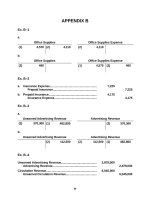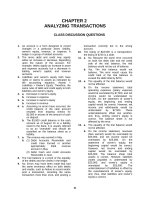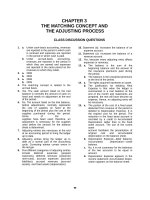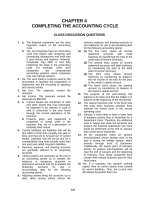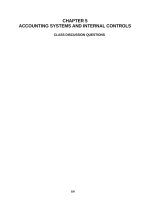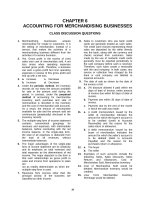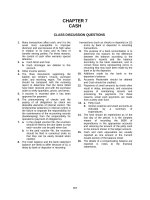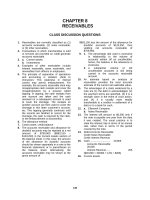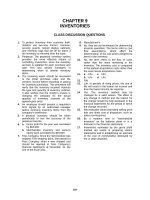Solution manual accounting 21e by warreni ch 20
Bạn đang xem bản rút gọn của tài liệu. Xem và tải ngay bản đầy đủ của tài liệu tại đây (212.07 KB, 44 trang )
CHAPTER 20
COST BEHAVIOR AND
COST-VOLUME-PROFIT ANALYSIS
CLASS DISCUSSION QUESTIONS
1. Total variable costs vary in direct proportion
to changes in the level of activity. Unit
variable costs remain the same with
changes in the level of activity.
2. a. Variable costs
b. Variable costs
c. Variable costs
3. a. Total fixed costs remain the same as
the level of activity increases.
b. Unit fixed costs decrease as the level of
activity increases.
4. a. Fixed costs
b. Fixed costs
c. Fixed costs
5. Mixed costs are separated into their fixed
and variable cost components.
6. (a)
7. (b)
8. (a)
9. The total variable cost (variable cost per
unit times total units produced) at either the
highest or lowest level of production is
determined, and this amount is subtracted
from the total cost at that level to determine
the total fixed cost.
10. a. No impact on the contribution margin.
b. Income from operations would decline.
11. A high contribution margin ratio, coupled
with idle capacity, indicates a potential for
in-
creased income from operations if additional
sales can be made. A large percentage of
each additional sales dollar would be
available, after providing for variable costs,
to cover promotion efforts and to increase
income
from
operations.
Thus,
a
substantial sales promotion campaign
should be considered in order to expand
sales to maximum capacity and to take
advantage of the low ratio of variable costs
to sales.
12. Decreases in unit variable costs, such as a
decrease in the unit cost of direct materials,
will decrease the break-even point.
13. Increases in total fixed costs will increase
the break-even point.
14. Simmons Company had lower fixed costs
and a higher percentage of variable costs
to sales than did Pate Company. Such a
situation resulted in a lower break-even
point for Simmons Company.
15. The individual products are treated as
components of one overall enterprise
product. These components are weighted
by the sales mix percentages.
16. Operating leverage measures the relative
mix of a business’s variable costs and fixed
costs. It is computed as follows:
Operating leverage =
Contribution margin
Income from operations
113
EXERCISES
Ex. 20–1
1.
2.
3.
4.
5.
6.
7.
8.
Variable
Fixed
Variable
Mixed
Fixed
Variable
Variable
Variable
9.
10.
11.
12.
13.
14.
15.
Ex. 20–2
a.
b.
c.
d.
e.
Cost Graph Two
Cost Graph Three
Cost Graph Four
Cost Graph Three
Cost Graph One
Ex. 20–3
1.
2.
3.
4.
5.
6.
a
d
e
c
c
b
114
Variable
Fixed
Mixed
Variable
Variable
Fixed
Variable
Ex. 20–4
1. e
2. a
3. g
Ex. 20–5
a.
b.
c.
d.
e.
f.
Variable
Fixed*
Fixed
Variable
Variable
Variable
g.
h.
i.
j.
k.
l.
Fixed
Variable
Variable
Fixed
Variable
Fixed
*The developer salaries are fixed because they are more variable to the number of
titles or releases, rather than the number of units sold. For example, a title could
sell one copy or a million copies, and the salaries of the developers would not be
affected.
115
Ex. 20–6
Cassettes produced........
Total costs:
Total variable costs....
Total fixed costs.........
Total costs..................
Cost per unit:
Variable cost per unit.
Fixed cost per unit.....
Total cost per unit......
200,000
300,000
400,000
$ 800,000
180,000
$ 980,000
(d) $ 1,200,000
(e)
180,000
(f) $ 1,380,000
(j) $ 1,600,000
(k)
180,000
(l) $ 1,780,000
(g) $
(h)
(i) $
(m) $
(n)
(o) $
(a) $
(b)
(c) $
4.00
0.90
4.90
4.00
0.60
4.60
4.00
0.45
4.45
Supporting calculations:
a.
$4.00 ($800,000 ÷ 200,000 units)
b.
d.
e.
g.
$0.90 ($180,000 ÷ 200,000 units)
$1,200,000 ($4.00 × 300,000)
$180,000 (fixed costs do not change with volume)
$4.00 ($1,200,000 ÷ 300,000 units; variable costs per unit do not change with
changes in volume)
h. $0.60 ($180,000 ÷ 300,000 units)
j. $1,600,000 ($4.00 × 400,000 units)
k. $180,000 (fixed costs do not change with volume)
m. $4.00 ($1,600,000 ÷ 400,000 units, variable costs per unit do not change with
changes in volume)
n. $0.45 ($180,000 ÷ 400,000 units)
116
Ex. 20–7
a.
Variable cost per unit =
Difference in total costs
Difference in production
Variable cost per unit =
$432,500
15,000 units
Variable cost per unit =
$195,000
= $19.50 per unit
10,000 units
$237,500
5,000 units
The fixed cost can be determined by subtracting the estimated total variable
cost from the total cost at either the highest or lowest level of production, as
follows:
Total cost = (Variable cost per unit × Units of production) + Fixed cost
Highest level:
$432,500 = ($19.50 × 15,000 units) + Fixed cost
$432,500 = $292,500 + Fixed cost
$140,000 = Fixed cost
Lowest level:
$237,500 = ($19.50 × 5,000 units) + Fixed cost
$237,500 = $97,500 + Fixed cost
$140,000 = Fixed cost
b. Total cost = (Variable cost per unit × Units of production) + Fixed cost
Total cost for 12,000 units:
Variable cost:
Units..........................................
12,000
Variable cost per unit................
× $19.50
Total variable cost....................
$234,000
Fixed cost..................................
140,000
Total cost...................................
$374,000
117
Ex. 20–8
Variable cost per
gross-ton mile
=
Difference in total costs
Difference in gross-ton miles
Variable cost per
gross-ton mile
=
$1,748,000 $1,322,000
840,000 gross-ton miles 485,000 gross-ton miles
Variable cost per
gross-ton mile
=
$426,000
355,000 gross-ton miles
= $1.20 per gross-ton mile
The fixed cost can be determined by subtracting the estimated total variable cost
from the total cost at either the highest or lowest level of gross-ton miles, as
follows:
Total cost = (Variable cost per gross-ton mile × Gross-ton miles) + Fixed cost
Highest level:
$1,748,000 = ($1.20 × 840,000 gross-ton miles) + Fixed cost
$1,748,000 = $1,008,000 + Fixed cost
$740,000 = Fixed cost
Lowest level:
$1,322,000 = ($1.20 × 485,000 gross-ton miles) + Fixed cost
$1,322,000 = $582,000 + Fixed cost
$740,000 = Fixed cost
118
Ex. 20–9
a.
Sales.....................................
Variable costs......................
Contribution margin............
Contribution margin ratio =
$560,000
364,000
$196,000
Sales
Variable costs
Sales
Contribution margin ratio =
$196,000
= 35%
$560,000
Sales.....................................
Contribution margin ratio. . .
Contribution margin............
Less fixed costs..................
Income from operations......
$264,000
×
42%
$110,880
100,000
$ 10,880
b.
Ex. 20–10
a.
Sales....................................................................................................
Variable costs:
Food and packaging......................................................................
Payroll............................................................................................
General, selling, and administrative expenses (40% × $1,919)
Total variable costs..................................................................
Contribution margin............................................................................
$14,870
$ 3,802
2,901
768
$ 7,471
$ 7,399
b.
Contribution margin ratio =
Contribution margin ratio =
c.
Sales
Variable costs
Sales
$7,399
= 49.76%
$14,870
Same-store sales increase............................................
Contribution margin ratio (from b)...............................
Increase in income from operations.............................
$300,000,000
×
49.76%
$149,280,000
Note: Part (c) emphasizes “same-store sales” because of the assumption of no
change in fixed costs. McDonald’s will also increase sales from opening new
stores. However, the impact on income from operations for these additional sales
would need to include an increase in fixed costs into the calculation.
119
Ex. 20–11
a.
Break-even sales (units) =
Fixed costs
Unit contribution margin
Break-even sales (units) =
$345,600
= 19,200 units
$50 $32
b. Sales (units) =
Sales (units) =
Fixed costs + Target profit
Unit contribution margin
$345,600 + $45,900
= 21,750 units
$50 $32
Ex. 20–12
a.
Break-even sales (units) =
Fixed costs
Unit contribution margin
$3,625,800,000 1
Break-even sales (units) =
= 61,288,032 barrels
$120.66 2
$52.013 $9.49 4
The variable costs per unit are determined by multiplying the total amount of
each cost by the variable cost percentage (70% for production costs and 45%
for marketing and distribution costs), then dividing by the number of barrels.
1
($7,950,000,000 × 30%) + ($2,256,000,000 × 55%)
2
$12,911,000,000 ÷ 107,000,000
3
($7,950,000,000 × 70%) ÷ 107,000,000
4
($2,256,000,000 × 45%) ÷ 107,000,000
b. Break-even sales (units) =
$3,625,800 ,000 + $110,000,0 00
= 63,147,397 barrels
$120.66
$52.01
$9.49
120
Ex. 20–13
a.
Break-even sales (units) =
Fixed costs
Unit contribution margin
Break-even sales (units) =
$540,000
= 7,200 units
$250
$175
b. Break-even sales (units) =
Break-even sales (units) =
Fixed costs
Unit contribution margin
$540,000
= 4,320 units
$300
$175
Ex. 20–14
Break-even sales (units) =
Fixed costs
Unit contribution margin
Break-even sales (units) =
$120,000
= 14,000 units
$18
$X
Variable cost per unit: $120,000 = $14,000 ($18 – $X)
Variable cost per unit:
$120,000
= $18 – $X
14,000
Variable cost per unit: $8.57 = $18 – $X
Variable cost per unit: $9.43 (rounded)
121
Ex. 20–15
The cost of the promotion campaign is a fixed cost in this analysis, since we’re
trying to determine the break-even adoption rate of the campaign (not break-even
for AOL as a whole):
800,000 people × $3.00 = $2,400,000
The contribution margin earned per new customer is essentially the revenue
earned less the variable cost over the 30-month service period.
Revenue: (30 mos. – 3 free mos.) × $20/mo. = $540 per new account
[Variable cost: 30 mos. × $2.00/mo. = $60 per new account.]
The break-even number of new accounts necessary to cover the fixed cost of the
promotion would be:
Break-even =
Fixed cost
Contribution margin per unit
Break-even =
$2,400,000
= 5,000 accounts
$540 $60 per account
Therefore, if AOL yielded more than 5,000 new accounts out of 800,000 mailings
(0.625%), the costs of the campaign would be covered. However, AOL would need
to yield much more than this in order to be successful as a company, since its
corporate fixed costs must also be covered.
122
Ex. 20–16
a.
Break-even =
Fixed cost
Revenue per account Variable cost per account
$4,418,700 ,000 3
Break-even =
$887 1 $3712
Break-even = 8,563,372 accounts
1
Revenue per account:
$7,689,000,000 ÷ 8,666,500 accounts = $887 (rounded)
2
Variable cost per account:
Cost of revenue................................... $2,869,000,000 × 70% = $ 2,008,300,000
Selling, general, and administrative
expenses........................................ 3,020,000,000 × 40%
1,208,000,000
Total variable cost...............................
$ 3,216,300,000
Divided by number of accounts.........
÷
8,666,500
Variable cost per account (rounded)
$
371
3
Fixed costs:
Cost of revenue................................... $2,869,000,000 × 30%
Selling, general, and administrative
expenses........................................ 3,020,000,000 × 60%
Depreciation........................................ 1,746,000,000 × 100%
Total fixed costs..................................
b. Break-even =
$
860,700,000
1,812,000,000
1,746,000,000
$ 4,418,700,000
Fixed cost
Revenue per account Variable cost per account
$4,418,700 ,000
X $371
8,666,500X – $3,215,271,500 = $4,418,700,000
8,666,500X = $7,633,971,500
X = $881 (rounded)
8,666,500 accounts =
Note to Instructors: The rate charged per minute and the number of average
minutes of digital service influence the revenue per account. An interesting
question is whether the costs are variable to the number of minutes or
number of accounts. If we assume that the costs are variable to the number of
minutes, then the break-even analysis revolves around the number of
minutes. More likely, the costs are more variable to the number of accounts
for this business (mostly customer acquisition and service costs), while the
variable cost per minute is likely to be small.
123
Ex. 20–17
a.
Operating Profit Area
Total
Sales
Break-Even
Point
$3,000,000
Sales and Cost
$2,500,000
$2,000,000
Total Costs
$1,500,000
$1,000,000
$500,000
Operating Loss Area
$0
0
10,000
20,000
30,000
40,000
Units of Sales
b. $1,800,000 (the intersection of the total sales line and the total costs line)
c. The graphic format permits the user (management) to visually determine the
break-even point and the operating profit or loss for any given level of sales.
124
Ex. 20–18
a.
$450,000 (total fixed costs)
b. Sales (40,000 units × $60)........................................
Fixed costs...............................................................
Variable costs (40,000 units × $45)..........................
Income from operations...........................................
$2,400,000
$ 450,000
1,800,000
$
2,250,000
150,000
c.
$200,000
Break-Even
Point
$100,000
Operatin
g
Profit
Area
Profit
$0
10,000
$(100,000)
$(200,000)
Operating
Loss Area
20,000
30,000
40,000
Units of Sales
$(300,000)
$(400,000)
$(500,000)
d. 30,000 units (the intersection of the profit line and the horizontal axis)
Ex. 20–19
Cost-volume-profit chart
a. fixed costs
b. operating loss area
c. operating profit area
d.
e.
f.
125
break-even point
total costs
sales
Ex. 20–20
Profit-volume chart
a. break-even point
b. fixed costs
c. operating loss area
d. operating profit area
e. profit line
f. maximum income from operations
Ex. 20–21
a.
Unit selling price of E = ($2.80 × 0.60) + ($2.00 × 0.40)
Unit selling price of E = $1.68 + $0.80 = $2.48
Unit variable cost of E = ($1.10 × 0.60) + ($0.80 × 0.40)
Unit variable cost of E = $0.66 + $0.32 = $0.98
Unit contribution margin of E = $2.48 – $0.98 = $1.50
Break-even sales (units) =
Fixed costs
Unit contribution margin
Break-even sales (units) =
$300,000
= 200,000 units
$1.50
b. 120,000 units of potato chips (200,000 units × 0.60)
80,000 units of pretzels (200,000 units × 0.40)
126
Ex. 20–22
a.
Unit contribution margin of overall product (E):
Unit selling price of E [(25% × $400) + (75% × $240)].......................
Unit variable cost of E [(25% × $58) + (75% × $34)]..........................
Unit contribution margin of E.............................................................
Fixed costs of the New York to Miami round trip flight:
Fuel.......................................
$ 3,690
Flight crew salaries.............
7,510
Depreciation.........................
3,200
Total fixed costs..................
$14,400
Break-even in sales (units) of overall product:
Break-even sales (units) =
Fixed costs
Unit contribution margin
Break-even sales (units) =
$14,400
= 60 seats (tickets)
$240 per seat
b. Business class break-even (60 seats × 25%)...............
Tourist class break-even (60 seats × 75%)...................
Total break-even.............................................................
15 seats
45 seats
60 seats
Ex. 20–23
a.
(1) $100,000 ($400,000 – $300,000)
(2) 25% ($100,000 ÷ $400,000)
b. The break-even point (S) is determined as follows:
Sales = $450,000 + 60% Sales
Sales – 60% Sales = $450,000
40% Sales = $450,000
Sales = $1,125,000
If the margin of safety is 25%, the sales are determined as follows:
Sales = $1,125,000 + 25% Sales
Sales – 25% Sales = $1,125,000
75% Sales = $1,125,000
Sales = $1,500,000
127
$280
40
$240
Ex. 20–24
If 20,000 units are sold and sales at the break-even point are 23,000 units, there is
no margin of safety.
Ex. 20–25
a.
Abdel Inc.:
Operating leverage =
Contribution margin
Income from operations
Operating leverage =
$60,000
= 1.20
$50,000
Hui Inc.:
Operating leverage =
Contribution margin
Income from operations
Operating leverage =
$75,000
= 5.00
$15,000
b. Abdel Inc.’s income from operations would increase by 24% (1.20 × 20%), or
$12,000 (24% × $50,000), and Hui Inc.’s income from operations would
increase by 100% (5.0 × 20%), or $15,000 (100% × $15,000).
c. The difference in the increases of income from operations is due to the
difference in the operating leverages. Hui Inc.’s higher operating leverage
means that its fixed costs are a larger percentage of contribution margin than
are Abdel Inc.’s. Thus, increases in sales increase operating profit at a faster
rate for Hui than for Abdel.
128
Appendix Ex. 20–26
a. Variable cost of goods sold
b. Variable selling and administrative expenses
c. Fixed costs and expenses
Appendix Ex. 20–27
FRANKLIN PEN COMPANY
Income Statement—Variable Costing
For the Month Ended July 31, 2005
Sales...................................................................................
Variable cost of goods sold:
Variable cost of goods manufactured.......................
Less ending inventory (900 units × $36.50)..............
Variable cost of goods sold...................................
Manufacturing margin.......................................................
Variable selling and administrative expenses.................
Contribution margin..........................................................
Fixed costs:
Fixed manufacturing costs........................................
Fixed selling and administrative expenses...............
Income from operations....................................................
$564,000
$470,850
32,850
438,000
$126,000
30,000
$ 96,000
$ 32,250
23,400
55,650
$ 40,350
Computations:
Variable cost of goods manufactured: $503,100 – $32,250 = $470,850
Unit cost of ending inventory:
Variable cost of goods manufactured per unit:
$470,850 ÷ 12,900 units manufactured = $36.50
Thus, variable cost of goods sold could alternatively be calculated:
$438,000 = 12,000 units × $36.50/unit
Fixed selling and administrative expenses: $53,400 – $30,000 = $23,400
Note: The difference between the two income numbers can be reconciled as
follows:
Unit change in inventory......................................
Fixed overhead per unit.......................................
Income from operations difference.....................
*$32,250 ÷ 12,900 units
129
900 units
× $2.50*
$ 2,250
Appendix Ex. 20–28
TIDY SOAP COMPANY
Income Statement—Absorption Costing
For the Month Ended June 30, 2005
Sales...................................................................................
Cost of goods sold:
Cost of goods manufactured (1,350 units × $79).....
Less ending inventory (150 units × $79)...................
Cost of goods sold.................................................
Gross profit........................................................................
Selling and administrative expenses ($16,800 + $61,400)
Income from operations....................................................
$192,000
$106,650
11,850
94,800
$ 97,200
78,200
$ 19,000
Computations:
Cost of goods manufactured: $74,250 + $32,400 = $106,650
Unit cost of ending inventory:
Total cost of goods manufactured: $106,650 ÷ 1,350 units
manufactured = $79
Note: The difference between the two income numbers can be reconciled as
follows:
Unit change in inventory......................................
Fixed overhead per unit.......................................
Income from operations difference.....................
*$32,400 ÷ 1,350 units = $24
130
150 units
× $24*
$3,600
PROBLEMS
Prob. 20–1A
Cost
a.
Fixed
Cost
X
Variable
Cost
Mixed
Cost
b.
X
c.
X
d.
e.
X
X
f.
X
g.
X
h.
X
i.
X
j.
X
k.
X
l.
X
m.
n.
X
X
o.
X
p.
X
q.
X
r.
X
s.
X
t.
X
131
Prob. 20–2A
1.
Cost of goods sold.............................................
Selling expenses.................................................
Administrative expenses....................................
Total.....................................................................
Fixed Costs
$ 600,000
300,000
150,000
$1,050,000
2.
a.
b.
3.
Break-even sales (units) =
Fixed costs
Unit contribution margin
Break-even sales (units) =
$1,050,000
= 35,000 units
$30
$32.50 ($1,950,000 ÷ 60,000 units)
$30 ($62.50 – $32.50)
4. Break-even sales (units) =
Break-even sales (units) =
5.
6.
7.
Variable Costs
$ 900,000
900,000
150,000
$1,950,000
Fixed costs
Unit contribution margin
$1,050,000 $180,000
= 41,000 units
$30
Sales (units) =
Fixed costs Target profit
Unit contribution margin
Sales (units) =
$1,230,000 $750,000
$1,980,000
=
= 66,000 units
$30
$30
Sales ($3,750,000 + $600,000)....................................
Less: Fixed costs......................................................
Variable costs (69,600* units × $32.50)..........
Income from operations.............................................
Present operating income..........................................
Less additional fixed costs........................................
Income from operations.............................................
132
$ 4,350,000
$1,230,000
2,262,000
$
$
$
3,492,000
858,000
750,000
180,000
570,000
Prob. 20–2A
Concluded
8. In favor of the proposal is the possibility of increasing income from
operations from $750,000 to $858,000. However, there are many points against
the proposal, including:
a. The break-even point increases by 6,000 units (from 35,000 to 41,000).
b. The sales necessary to maintain the current income from operations of
$750,000 would be 66,000 units, or $375,000 (6,000 units × $62.50) in
excess of 2006 sales.
c. If future sales remain at the 2006 level, the income from operations of
$750,000 will decline to $570,000.
The company should determine the sales potential if the additional product is
produced and then evaluate the advantages and the disadvantages
enumerated above, in light of these sales possibilities. Unless market
research strongly indicates that $375,000 to $600,000 ($4,350,000 –
$3,750,000) of additional sales can be made, the proposal should not be
accepted.
133
Prob. 20–3A
1.
Break-even sales (units) =
Fixed costs
Unit contribution margin
Break-even sales (units) =
$900,000
= 9,000 units
$100
2. Sales (units) =
Sales (units) =
Fixed costs + Target profit
Unit contribution margin
$900,000 + $150,000
$1,050,000
=
= 10,500 units
$100
$100
3.
Operating
Profit Area
$7,000,000
Sales and Cost s
$6,000,000
$5,000,000
$4,000,000
$3,600,000
Break-Even
Point
$3,000,000
Total
Costs
$2,000,000
$1,000,000
Operating
$0
Loss Area
Sales
0
2,000
4,000
6,000
8,000 10,000 12,000 14,000 16,000
9,000
Units of Sales
4. ($200,000) [7,000 × ($400 – $300) – $900,000]
134
Prob. 20–4A
1.
$900,000
Operating
Profit Area
$800,000
Sales and Cost s
$700,000
$600,000
Sales
$500,000
Total
Costs
$400,000
$300,000
Break-Even
Point
$200,000
$100,000
Operating
Loss Area $0
0
1,000
2,000
3,000
4,000
5,000
6,000
7,000
8,000
Units of Sales
Break-even =
$125,000
= 5,000 units or $400,000
$80
$55
135
9,000 10,000
Prob. 20–4A
Continued
2.
$900,000
}
$800,000
$624,000
$700,000
$700,000
Sales and Cost s
$675,000
b
$600,000
Operating
Profit Area
$500,000
a
$400,000
Sales
Total
Costs
Break-Even
Point
$300,000
$200,000
$100,000
Operating
Loss Area
$0
0
1,000
2,000
3,000
4,000
5,000
6,000
7,000
8,000
9,000 10,000
Units of Sales
Units sold: $400,000 ÷ $80 per unit = 5,000 units
Sales............................................................................
Variable costs..............................................................
Fixed costs..................................................................
Total costs...................................................................
Income from operations.............................................
136
a. 5,000
units
b. 10,000
units
$400,000
$275,000
125,000
$400,000
$
0
$800,000
$550,000
125,000
$675,000
$125,000
Prob. 20–4A
Continued
3.
$900,000
Operating
Profit Area
$800,000
Sales and Costs
$700,000
$600,000
$528,000
Sales
$500,000
Break-Even
Point
$400,000
$300,000
$200,000
$100,000
Operating
Loss Area
$0
0
1,000 2,000 3,000 4,000 5,000 6,000 7,000 8,000 9,000 10,000
6,600
Units of Sales
Break-even point: 6,600* units or $528,000
*
$125,000 $40,000
$80
$55
137
Total
Costs
